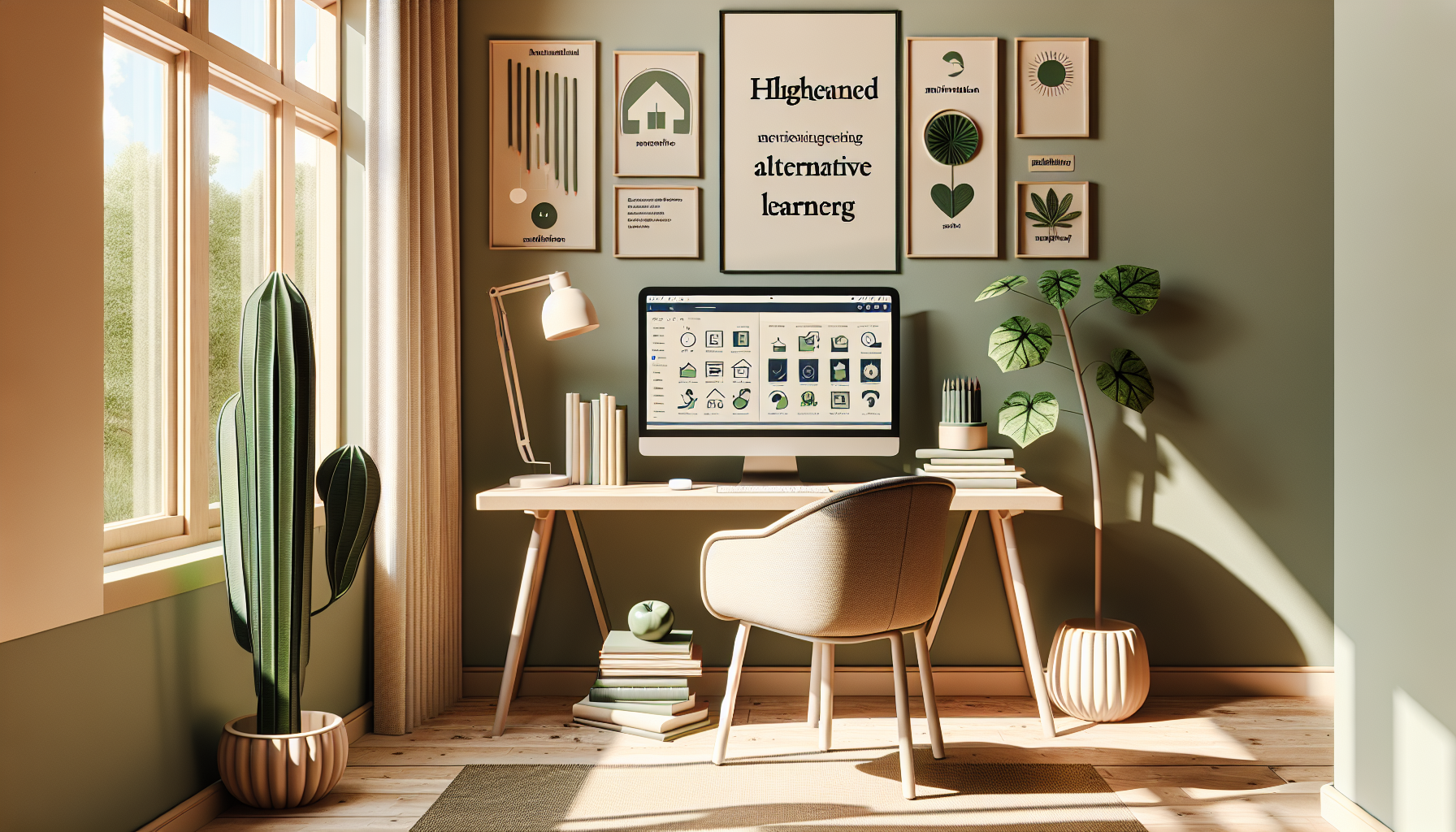Designing a course for non-traditional learners can feel like trying to solve a Rubik’s Cube blindfolded. You might be wondering how to engage folks who have different backgrounds, schedules, and learning styles. It’s a challenge, but you’re not alone in this confusion!
Stick around, and I promise to guide you through the process step-by-step. By the end, you’ll have a solid blueprint for creating courses that not only fit the needs of diverse learners but also ignite their passion for learning.
We’ll explore everything from understanding who these learners are, to choosing the right delivery methods, and continuously improving your course. Ready to dive in? Let’s get started!
Key Takeaways
- Understand non-traditional learners’ unique backgrounds and needs for effective course design.
- Offer flexible learning options like asynchronous and synchronous formats to accommodate busy schedules.
- Incorporate various teaching methods, including practical applications and interactive content.
- Utilize technology and online resources to enhance course accessibility and engagement.
- Establish strong support systems, such as academic advising and peer mentoring, for learners.
- Regularly assess learner progress and gather feedback to improve the course continuously.
- Be open to change and adapt your course based on learner insights and emerging educational trends.

Steps to Design a Course for Non-Traditional Learners
Designing a course for non-traditional learners can be quite different than for traditional students.
These learners often juggle multiple responsibilities like work, family, and personal obligations.
So, it’s vital to create a flexible course that respects their time and commitments.
Start by gathering insights about their unique needs and preferences, as this will inform your entire design process.
Consider incorporating a variety of learning methods, such as asynchronous online modules and live Q&A sessions, to accommodate varying schedules.
Understanding Non-Traditional Learners
Non-traditional learners come from diverse backgrounds and life experiences, including adult learners returning to education, veterans, and professionals seeking career advancement.
Their learning styles often reflect their unique circumstances, which means you should be prepared to adapt your teaching methods accordingly.
It’s helpful to recognize that many of these learners value practical applications rather than theory, so real-world scenarios can enhance their learning experience.
Engage with them through surveys or informal chats to better understand their motivations and obstacles.
Incorporating elements like peer support groups can also foster a sense of community among non-traditional students.
Identifying Learning Needs and Preferences
Spotting the specific learning needs and preferences of your audience is critical.
Start by conducting thorough assessments or surveys to gather information about their past experiences and future goals.
Ask questions about their preferred learning styles—some thrive in visual settings, while others may favor auditory or kinesthetic experiences.
Once you gather this data, tailor your course materials and delivery methods to meet their needs effectively.
For example, if your audience prefers hands-on learning, you could include practical projects and interactive activities.

Choosing Appropriate Course Formats and Delivery Methods
Selecting the right course formats and delivery methods is crucial for engaging non-traditional learners.
Since many of these learners have busy schedules, consider offering a mix of asynchronous and synchronous options.
Asynchronous courses let students learn at their own pace, which is great for those balancing work and studies.
Synchronous classes, like live webinars or sessions, can foster immediate interaction and discussion.
You might also explore blended learning, where online and in-person elements are combined.
This hybrid approach can offer the best of both worlds and cater to various preferences.
For instance, pre-recorded lectures can be complemented by live Q&A sessions to clarify doubts.
Ultimately, keep it diverse; some learners’ll appreciate quick video snippets, while others may prefer comprehensive reading materials.
Creating Engaging Content and Materials
Engaging content is key to keeping non-traditional learners motivated.
Consider employing storytelling techniques to make your lessons relatable and memorable.
Using real-life examples and case studies can help them see the practical value of what they’re learning.
Interactive elements such as quizzes, group discussions, and hands-on projects can also enhance participation.
Try to incorporate multimedia, like videos or infographics, to cater to different learning styles.
Regular updates and fresh content can keep the course material relevant and interesting.
Leverage platforms like educational videos to break down complex topics into digestible bites.
Don’t overlook the power of feedback—creating an environment where learners can share their thoughts on content helps improve the experience for everyone.
Incorporating Flexibility into Course Design
Flexibility is essential in course design, especially for non-traditional learners.
Allowing learners to set their own deadlines can significantly reduce stress and make them feel more in control.
Consider offering options to customize learning paths based on individual goals.
For example, let learners choose optional modules based on their interest or career aspirations.
Create a clear schedule but make it adaptable—if one week is particularly hectic, learners should feel comfortable catching up later.
Also, implementing self-paced assessments allows learners to demonstrate their understanding without pressure.
Flexibility not only accommodates diverse lifestyles but also fosters a positive learning experience.
Utilizing Technology and Online Resources
Technology plays a central role in enhancing the learning experience for non-traditional learners.
Utilize learning management systems (LMS) to organize course materials and track progress easily.
Online forums and chat groups can foster community support, allowing learners to connect and share experiences.
Consider tools like Google Classroom or Microsoft Teams to facilitate communication and collaboration.
Incorporating open educational resources (OER) can provide high-quality materials without financial barriers.
Platforms like Coursera and edX offer diverse content options.
Finally, encourage learners to leverage free resources like podcasts or YouTube channels that align with course topics while promoting lifelong learning.
Implementing Support Systems for Learners
Creating a strong support system is essential for non-traditional learners, who often face unique challenges.
Start by offering academic advising to help them navigate their educational journey.
Peer mentoring programs can connect learners with experienced students for guidance and support.
Regular check-ins, whether through email or virtual meetings, can help reinforce their progress and motivation.
Build a resource bank with links to tutoring services, counseling, or job placement assistance.
Encourage feedback through anonymous surveys to identify areas where learners feel they need more support.
A supportive atmosphere not only enhances learner retention but also fosters a sense of belonging.
Assessing Learner Progress and Feedback
Regular assessment of learner progress is key to understanding effectiveness.
Incorporate diverse assessment methods—think quizzes, projects, peer evaluations, and self-assessments.
Continuous feedback helps learners identify strengths and areas for improvement, which is crucial for their development.
For instance, consider 360-degree feedback, allowing peers to give and receive insights on each other’s work.
Encourage reflective practices, where learners assess their progress and set new goals.
This type of assessment fosters self-directed learning and can lead to deeper engagement.
Remember, assessment should not be punitive; instead, it should guide your learners to better understand their journey.
Continuous Improvement of the Course
Continuous improvement is vital for keeping your course relevant and effective.
Gather feedback at the end of each module and use it to enhance future iterations of the course.
Stay updated on emerging trends in education to integrate new methodologies and tools.
Consider revisiting your learning objectives regularly to ensure they meet the evolving needs of learners.
Incorporating learner success stories can showcase the course’s impact and motivate current students.
Collaborating with fellow educators for insights or sharing best practices can also provide fresh perspectives.
Remember, being open to change is crucial in creating a dynamic learning environment that benefits everyone.
